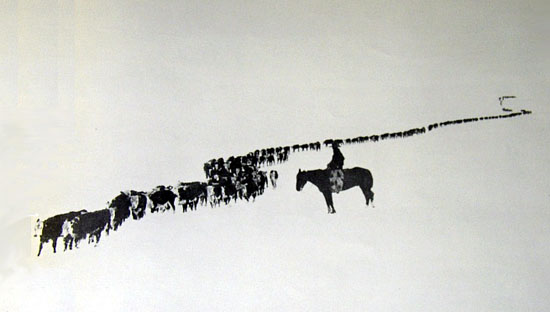 By Jacquie Rogers
By Jacquie RogersWhen we think of the Old West, we think of cowboys, cattle drives, open range, and wild times. And, from 1865 to 1886, this would be an accurate description. Then came the Great Die-Up, which many call the end of the Old West and the beginning of a different way of life. So what happened?
The demand for beef had grown steadily and remained strong through the 1870s and early 1880s. Ranchers bred more cattle, and they bred for more weight and meat rather than hardiness. That meant the herds were larger than ever before. And hungrier.
Farmers moved in by the droves and strung barbed wire around their homesteads, leaving less and less land for grazing. Sheep herders brought their flocks, and sheep rip the grass out by its roots, leaving no food for cattle. And then the drought hit during the summer of 1886.
By the fall of 1886, range land in the north (the Dakotas, Montana, and Wyoming) was greatly diminished in size by encroachments, the grass had been over-grazed for a couple years, and the drought killed what grass there was left.
The winters of the previous decade had been uncommonly mild, but the ranchers didn't know that--only the Native Americans and the mountain men had any experience with the frontier. The cattle had wintered well without extra feed, and subsequently the ranchers quit stockpiling feed, which was quite an expensive endeavor.
 So when the snows hit, and it snowed nearly every day in November of 1886, the cattle had to use their hooves to dig through the snow to uncover what meager grasses they could find. The already thin animals grew weak from hunger. The cattle that managed to live through the brutal months of November and December were greeted by a warm Chinook in January that melted the top layer of snow. Cattlemen who'd been standing by helplessly, with no feed in reserve, while their cows died by the dozens, thought they'd make it through the rest of the winter with their herds in fairly decent shape, or at least alive.
So when the snows hit, and it snowed nearly every day in November of 1886, the cattle had to use their hooves to dig through the snow to uncover what meager grasses they could find. The already thin animals grew weak from hunger. The cattle that managed to live through the brutal months of November and December were greeted by a warm Chinook in January that melted the top layer of snow. Cattlemen who'd been standing by helplessly, with no feed in reserve, while their cows died by the dozens, thought they'd make it through the rest of the winter with their herds in fairly decent shape, or at least alive.Then the temperatures dropped to -50F and under causing a layer of ice to freeze solid over the snow beneath.
It was all so slow, plunging after them through the deep snow that way. The horses' feet were cut and bleeding from the heavy crust, and the cattle had the hair and hide wore off their legs to the knees and hocks. It was surely hell to see big four-year-old steers just able to stagger along. ~Teddy Blue AbbottAfter the cattle had pawed down to the bare earth, seldom did they find anything to eat. Livestock invaded the outskirts of towns, eating whatever shrubs and bushes they could find. More snow came, more animals died, and despair spread over the land.
When warmer weather finally melted the snow and thawed the earth, rotting carcasses were scattered all over the landscape. Dead animals fouled the creeks and streams. Over 50% of all the cattle alive in October, 1886, were dead by April, 1887--probably about a million animals. Many ranchers went bankrupt, and the rest struggled to hang on.
So ended the days of open range and a whole way of life. Ranchers fenced off vast acreages to grow hay and grain for their remaining herds. Itinerant cowboys had to find other work, or settle for being a ranch hand. More farmers moved in, bringing their wives, children, merchants, churches, and schools. Railroads built more tracks and provided service to more outlying areas.
Thus, the modern West was born. And so it is today.
Down Home Ever Lovin' Mule Blues (See the Book Video featuring Justin Saragueta)
Jacquie's website * 1st Turning Point * Myspace * Twitter * Facebook Faery Special Romances * Royalties go to Children's Tumor Foundation, ending Neurofibromatosis through Research
